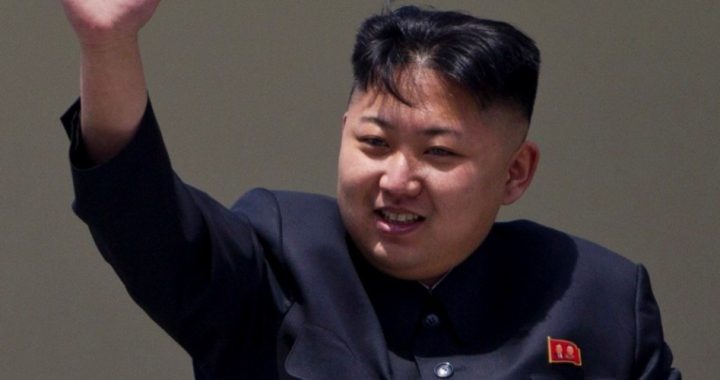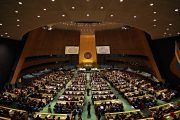
Following an announcement from North Korea April 3 that its military had been cleared to launch a nuclear attack against the United States, South Korean news sources said that North Korea had placed two of intermediate range missiles on mobile launchers and transferred them to the east coast of the country. The movement was apparently meant as a demonstration from the North that it was prepared to make good on its threats against the United States.
Reuters News reported that the missiles on the launchers may have the ability to reach Japan and some U.S. Pacific bases. “Speculation centered on two kinds of missiles, neither of which is known to have been tested,” reported Reuters. “One was the so-called Musudan missile which South Korea’s Defense Ministry estimates has a range of up to 3,000 km (1,865 miles). The other is called the KN-08, which is believed to be an inter-continental ballistic missile, which is again untested.”
The latest developments are a followup to North Korean dictator Kim Jong-un’s (shown) declaration March 28 that his country was prepared “to settle accounts with the U.S.” after two American B-2 Stealth bombers participated in South Korean military exercises, flying close to the northern border to drop training munitions in what appeared to be a subtle warning against North Korea’s military flexing.
Though verbal threats from North Korea have been customary over the past several decades, Kim’s more aggressive actions have prompted a serious response from the Pentagon, which has said it is taking North Korea’s actions as a real threat. The renewed tensions come just a month into the administration of South Korea’s new president, Park Geun-hye, and follow UN sanctions in response to a series of nuclear tests conducted by North Korea.
In the wake of North Korea’s actions, the United States has sent Navy vessels into the region, and has moved missile defense systems to U.S. bases in Guam as a precautionary measure. CNN reported that while Defense Department officials say a missile launch from North Korea is possible, such a launch would likely be a test rather than an actual attack, because the missiles don’t appear to be aimed at U.S. targets.
Meanwhile, the United States is trying to send more positive subtle diplomatic signals to North Korea that it hopes will serve to defuse the situation. “We are trying to turn the volume down,” a Defense Department official was quoted by CNN as saying. “We accused the North Koreans of amping things up, and now we are worried we did the same thing.”
State Department spokeswoman Victoria Nuland explained that the military moves on the part of the United States “are designed to ensure and to reassure the American people and our allies that we can defend the United States, that we will and that we can defend our allies.” She added that “we have also been saying all the way through that this does not need to get hotter, that we can change course” if North Korea is willing to back down on its aggressive stance.
Observers say that North Korea’s rhetoric appears to be aimed in part at establishing the reputation of Kim Jong-un as a tough leader and an exacting negotiator. In one of its latest postures, North Korea accused the United States of pursuing “ceaseless war moves since their occupation of South Korea, creating a touch-and-go situation several times.” The statement, released by North Korea’s “National Peace Committee,” warned that the United States is “seriously mistaken if it thinks it can frighten the DPRK [Democratic People’s Republic of Korea]” with its nuclear weaponry, apparently a reference to the appearance of the B-2 Stealth bombers. “Cutting-edge weapons are not a monopoly of the U.S.,” the statement continued, “and gone are the days never to return when it could invade other countries with nukes as it pleased. The U.S. and the South Korean warmongers had better stop their rash actions, deeply aware of the gravity of the prevailing situation.”
While it appeared that a North Korean missile could conceivably strike an unprotected U.S. military base in the Pacific, most experts say there seems to be little danger of a nuclear attack on the American mainland. “I don’t believe North Korea has to capacity to attack the United States with nuclear weapons mounted on missiles, and won’t for many years,” said nuclear scientist Siegfried Hecker, a senior fellow at the Center for International Security and Cooperation at Stanford University. “Its ability to target and strike South Korea is also very limited.”
He added that “even if Pyongyang had the technical means, why would the regime want to launch a nuclear attack when it fully knows that any use of nuclear weapons would result in a devastating military response and would spell the end of the regime?”
U.S. National Security Council spokesperson Caitlin Hayden said North Korea’s continued rhetoric was “unhelpful and unconstructive,” calling the latest words “yet another offering in a long line of provocative statements that only serve to further isolate North Korea from the rest of the international community and undermine its goal of economic development.”
U.S. officials appear to be hoping that China, North Korea’s only major ally, will step in to help defuse the situation. The International Business Times reported that Beijing has grown increasingly frustrated with North Korea’s belligerent attitude over the past several months. “Following the North’s third nuclear test in early February, China announced its opposition to Pyongyang’s advances in nuclear technology and threats of warfare, and even came around to backing U.N. Security Council sanctions,” reported the Times. “China has repeatedly called for restraint from all nations involved, calls that seem to have gone unheard.”
As the military actions of both North Korea and the United States have continued over the past two weeks, China has responded with actions of its own that could prove of concern to all involved. Chinese officials said that the country’s People’s Liberation Army (PLA) has increased its presence and operations on the border with North Korea in China’s Liaoning and Jilin provinces. Reports coming out of the Jilin province said that on March 19, the day American B-2 bombers made their appearance over South Korea, Chinese troops in the region were raised to a “Level One” alert status, China’s highest level of military preparedness.
According to the the Washington Times, China’s actions included flight drills with warplanes in the area, as well as naval maneuvers that included live-fire drills in the Yellow Sea off the Korean Peninsula.
However, the fact that China’s Foreign Ministry spokesman, Hong Lei, called North Korea’s aggressive behavior “highly regrettable” appears to indicate that China would like to see North Korea return to its typical quiet isolation. Former Assistant Secretary of State Kurt Campbell told a panel April 4 at the Johns Hopkins School of Advanced International Studies that he thinks Chinese officials “recognize that the actions North Korea has taken in recent months and years are in fact antithetical to their own national security interests.” He added that there appears to be “a subtle shift in Chinese foreign policy” toward North Korea. With their militaristic posturing and aggressive rhetoric, Kim Jong-un and fellow North Korean officials “have succeeded in undermining trust and confidence in Beijing,” he said.
Asia expert Hyun Lee concurred, saying that while Beijing is certainly not going to turn on North Korea, neither does it want an increased U.S. presence in the area, much less fighting on its borders. China “doesn’t want to deal with headaches like the tension between the U.S. and North Korea,” said Lee, adding that China’s words and actions appear to be part of an attempt to bring restraint to both sides.
Photo of Kim Jong-un: AP Images



